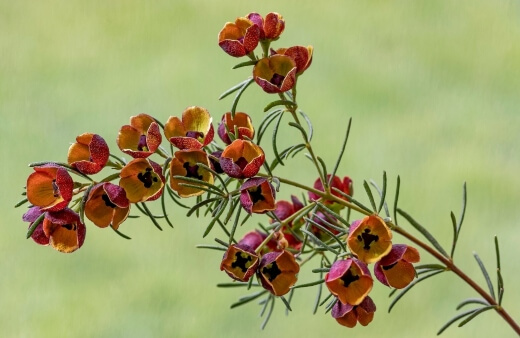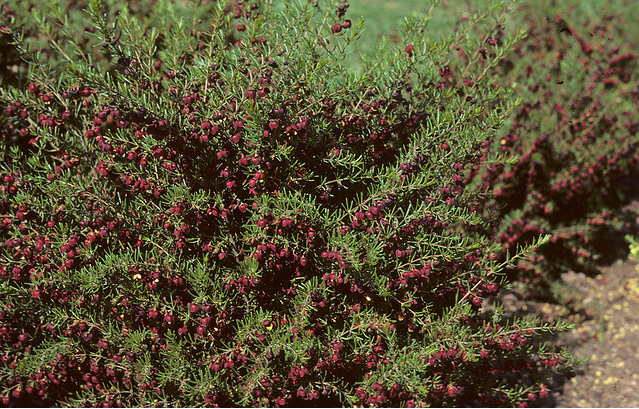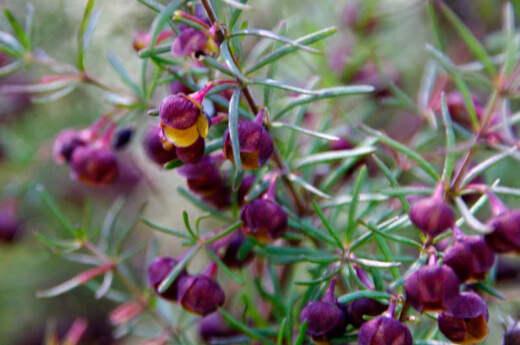Boronias are a very popular Australian native plant grown for their fragrance and exquisite blooms. Boronia megastigma is a smaller growing bush, reaching only about a metre in height.
Often used commercially as a cut flower, the Boronia megastigma can be an amazing and aromatic addition to your garden, balcony or courtyard. Follow our growing guide to care for, cultivate and grow brilliantly blooming Boronia megastigma.
More...
Boronia megastigma Features
Family: Rutaceae
Genus:
Boronia
Species: B. megastigma
Common Name: Brown Boronia, Sweet-Scented Boronia, and Scented Boronia
Flower Colour: Yellow and Brown
Foliage Colour: Green
Growth Habit: Shrub to 1m
Flowering: Spring
Boronias are commonly used in the cut flower trade and so are quite highly sought after. They are also very aromatic, which means they have a wonderful perfume.
Another use for the Boronia megastigma is as a source for essential oils to make perfumes and other things which smell like Boronia. Boronia megastigma is a relatively small growing variety, growing into a bush of about 1m x 1m.
Boronia’s can be a fickle plant, including the Boronia megastigma and really are only suited to temperate or cool climates, with an emphasis towards the cooler climate. Grow Boronia megastigma in a well draining soil in a sunny to part shade location.
Understanding the Boronia megastigma Species
Boronia megastigma, or brown boronia, stems from the Rutaceae family, a common Aussie native which grows naturally from Perth to Albany. Named after an Italian botanist, this incredible flowering plant is considered a smaller, slow-growing shrub.
Not only does the brown boronia produce remarkable, bulbous blooms, but it is an incredibly fragrant plant, producing sweet, citrus aromas throughout its growth cycle.

Boronia megastigma has a few cultivars, each with its own unique characteristics. These include:
- Boronia megastigma ‘Harlequin’ - This cultivar produces bright yellow blooms, with a slight red tinge on the outer petals.
- Boronia megastigma ‘Chandleri’ - This cultivar’s blooms come in a deep red, with a few yellow petals in the centre.
- Boronia megastigma ‘Lutea’ - This cultivar has full yellow blooms.
How to Grow Boronia megastigma
While growing brown boronia might not always be the easiest, as this plant is known to be particularly picky, the gorgeous blooms in spring are always worth it.
Ideally, you want to keep your megastigma in a sheltered, shade dappled spot. Brown boronia is quite sensitive to wind, so it’s recommended to keep your plant in an area that doesn’t experience strong drafts.
Many gardeners recommend growing Boronia megastigma in a pot which helps you control conditions a little better. Brown boronia needs plenty of well-draining soil enriched with a mix of organic matter.
These plants have a shallow root system, which is very sensitive to extreme moisture. As such, it is advised to pour some gravel into the hole or pot in which you’re planting before placing the root ball. This will help to improve drainage.


Get Your Free Guide:
Master Growing Australian Natives eBook
A Must Have Complete Guide for Every Australian Garden
Get Your Free Guide:
Master Growing Australian Natives eBook
A Must Have Complete Guide for Every Australian Garden
Propagating Boronia megastigma
Unfortunately, this species is incredibly difficult to grow from seed. The seeds are very hardy and often refuse to germinate unless conditions are absolutely perfect.
Luckily, propagation from cuttings is often successful. Cuttings should be taken with a sterilised grafting knife from a healthy, blooming plant. Cuttings can also be purchased at certain garden centres which specialise in native plants.
Planting Brown Boronia In Pots
Most gardeners choose to grow megastigma in pots. Still, it’s important to choose the right kind of pot.
Be sure to:
- Choose a porous pot like Terracotta, which will allow any excess moisture to seep out.
- Choose a pot that is twice the size of the root ball. A pot around 30cm would be ideal.
- Use a quality potting mix that ensures adequate drainage.
You will want to avoid keeping a saucer under your pot, as this can often cause the soil to retain moisture.
How to Care for Brown Boronia
Now, it’s important to note that these plants are often short-lived. So, don’t be dismayed if your megastigma suddenly dies. One way to combat the short life span is through regular pruning.
Pruning should be done after flowering, and you can cut back as much as a third of the bush. This will help to stimulate new growth.
Here is our review of the best pruning shears for 2024.
Take care, however, not to prune your megastigma if it’s under any form of stress, as it won’t be able to bounce back. While this species is sensitive to too much humidity, it is important to keep your brown boronia well watered.
Due to the shallow root system, in the extreme heat of the summer can cause the root system to dry out. Water regularly, especially in summer.
Some gardeners recommend adding mulch or rocks around the base of the bush, which will help to keep the roots cool. A slow-release fertiliser can be added throughout the year.

Source: Erlithe.wordpress.com
Caring for Cut Megastigma Flowers
It’s a fantastic idea to keep brown boronia flowers in a vase in your home. They’ll be able to add a beautiful fragrance to your home. However, it’s important to care for them correctly.
You’ll need to:
- Cut flowers from the bush just before the blooms begin to open.
- Strip away the lower leaves. (These leaves can be kept, dried and used as potpourri)
- Keep the vase away from direct sun and any major drafts.
- Change the water daily.
This way, you’ll be able to boost the longevity of your cut flowers. It’s also important to note that megastigma flowers have an Ethylene sensitivity. As such, they should be kept well enough away from any fruits.
Brown Boronia Problems
While the biggest challenge with growing brown boronia is ensuring the right conditions, disease issues only arise when conditions are sub-optimal.
Scale and phytophthora fungus arises when there is too much humidity or moisture in the soil.
Boronia megastigma Frequently Asked Questions
Is boronia hard to grow?
These shrubs can be difficult to grow from seed as the seeds exhibit dormancy and are covered by a thick coating, making germination extremely difficult outside of the natural habitat of this genus. However, once they are established, boronias are quite easy to maintain and care for.
Is boronia a perennial?
The genus of evergreen shrubs includes many varieties, both annual and perennial. A very popular perennial species is the Red Boronia which is native to western Australia and sports very showy blossoms.
Can you grow boronia inside?
While growing boronias in the garden is recommended over growing them indoors, the fragrant blossoms make for excellent cut flower additions to indoor vase arrangements.
The most popular and perfumed boronia flowers for keeping in a vase inside are the brown boronia (B. megastigma) and the red boronia (B. heterophylla).
Can you grow boronia from cuttings?
Most species of boronia can be reliably propagated using stem cuttings. Root development may be more lateral than downwards but the plant should be able to establish itself with some care.
Does boronia need full sun?
Some boronias thrive in full sun but most will prefer dappled sunlight or partial shade. Some protection from the hot afternoon summer sun and the cold winter winds is ideal.
How big does a boronia grow?
Mature height can vary quite a lot between all the different boronia species and cultivars but generally, these plants are considered small to large shrubs, ranging from about 60 centimetres to 1.2 metres tall.
Is the boronia plant poisonous?
This genus of shrubs has not been recorded as toxic to people or pets.
What does boronia smell like?
Boronias can produce quite complex aromas that can differ from species to species. Many common characteristics between them include a deeply rich aroma with hints of natural green freshness with an earthy undertone.
Some can produce fruitier notes with woody accents.
How often should you water boronias?
These shrubs enjoy being well watered. As a general guide, watering deeply once every 3 to 4 days is recommended, or as needed in your specific area depending on rainfall and heat.

Wrapping Up Our Boronia megastigma Growing Guide
There are so many benefits to choosing to grow Aussie native plants, and with brown boronia, those benefits are ten-fold. As long as you give your Boronia megastigma a little extra attention, you should have plenty of beautiful growing blooms.
Published on January 7, 2023 by Aussie Green Thumb
Last Updated on September 10, 2024






